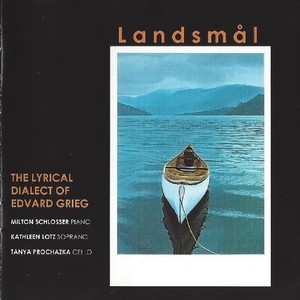
Landsmål
- 流派:Classical 古典
- 语种:英语
- 发行时间:1997-01-01
- 类型:录音室专辑
- 歌曲
- 时长
-
Lyriske Smaastykker (Lyric Pieces), Op. 43
-
Haugtussa (The Mountain Maid), Op. 67
-
Sonata for Cello and Piano, Op. 36
简介
Edvard Grieg (1843-1907) is the most significant Norwegian composer of the late nineteenth century, a period often designated as "nationalist-Romantic." Although initially trained at the Leipzig Conservatory in Germany, Grieg was to develop a compositional style which reflected the melodies, harmonies, and rhythms of Norwegian folksongs and dances. His activities as composer, conductor, pianist, and writer earned him numerous distinctions during his lifetime, including honourary doctorates from Cambridge and Oxford and membership in the Institut de France. Grieg composed numerous collections of short piano works entitled Lyric Pieces. He began the Opus 43 collection while he and his spouse, Nina, lived in Denmark during the winter of 1885-86. Grieg described the collection as "spring songs," a description clearly exemplified in the pieces "Butterfly," "Little Bird," and "To Spring." These musical portraits of spring are contrasted with pieces which evoke a sense of longing for the relationships and places which constituted Norway as home for Grieg. In particular, the piece "In My Homeland" was conceived by Grieg as a "letter" to his closest friend Frants Beyer, a person to whom Grieg wrote that "the colours are the soft colours of western Norway, but the heart of the piece was beating for you, old friend, as I was writing these notes." Music critics consider the song cycle Haugtussa (The Mountain Maid) to be one of Grieg's finest compositions. The lyrics are selections taken from the poem cycle of the same title written by Arne Garborg (1851-1924). Garborg--teacher, journalist, writer, linguist--was an enthusiast of the Norwegian dialect landsmal. Garborg's Haugtussa, with its descriptions of nature and country life, prompted Grieg to suggest while reading it that "the music is really already composed. One just needs to write it down." Grieg characterized landsmal as "a world of unborn music." The theme of Haugtussa is that of unrequited love. The central character is Velsemoy, a young woman who lives at home during the autumn and winter and moves to the mountain pastures with her herds during the spring and summer. She is considered to be strange by those in her community, as she is clairvoyant and is able to see spirits, including trolls. The complexity of her character is confirmed in the eight poems which Grieg chooses from the Garborg collection; her emotions range from ecstasy to desolation, with humour interspersed. Of interest is the fact that, unlike Franz Schubert's song cycle Die schone Mullerin (The Lovely Maid of the Mill), which also ends with a song by a brook, Haugtussa purports to articulate a female point of view. The Cello Sonata was written for the composer's brother, John. While the composer himself was critical of the composition (he felt it recycled too many ideas from his previous works), others were far more favourable in their reviews. Indeed, today the sonata is a standard work in the repertoire of cellists. The work exploits the full range of the cello and maximizes interplay between the cello and piano. From the outset of the first movement, melodic and rhythmic elements are used by Grieg to create drama and passion. The second movement opens and closes in gentle, lyrical fashion and is followed by the extensive third movement which contains the lively rhythm of the Norwegian halling dance.

